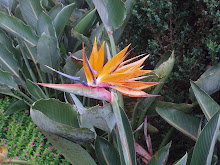Orang kata, bila kita berkunjung ke tempat orang adalah tidak lengkap kunjungan kita apatah lagi penghayatan kita terhadap budaya sesuatu tempat jika tak mencuba hidangan tradisi atau 'street-food' setempat. Rugi! Kerana pada pandangan peribadi saya, makanan sepertimana pakaian dan cara hidup adalah sebahagian daripada budaya.
Kali pertama berkunjung ke Saigon, Vietnam, saya seperti tipikal orang Malaysia yang lain tetap juga mencari makanan Melayu/Malaysia. Terus terang cakap, minda saya agak kurang terbuka nak mencuba makanan tradisi setempat gara-gara pengalaman yang agak kurang menarik di Bali dulu. Kerana kedua-dua tempat ini (Vietnam dan Bali) bukanlah negara Islam, jadi memang tak boleh expect jumpa halal food dengan mudah. Apatah lagi nak jumpa traditional food yang halal. Jangan salah faham, di Bali bukan tak ada halal food. Ada. Pilihannya terhad iaitu masakan padang which is bukan traditional food Bali. Kalau sudi boleh cuba makan dari penjaja kereta sorong atau penjaja menjunjung bakul. Tapi tahap kebersihan sukar ditebak.
Di Saigon pula, untungnya saya menginap di hotel yang terletak di sebuah jalan yang didominasi peniaga Islam berketurunan Melayu Champa. Nak makan halal tak susah. Tapi mahal untuk pengunjung berbajet rendah seperti kami. Kali pertama ke sana kami end up makan nasi berlaukkan ayam masak merah dan sayur. Masakan biasa orang Melayu kita. Hanya pada kunjungan kali kedua penghujung April lepas kami berpeluang menikmati kelazatan makanan tradisi masyarakat Vietnam iaitu Pho Bo atau Beef Noodle Soup - Kuetiaw Sup Daging.
Kekuatan pada Pho Bo ini pada saya terletak pada supnya. Sup yang sedap akan memberi keseluruhan rasa sedap pada hidangan ini. Sekali merasa Pho Bo saya dan mr hubby terus terpesona tahap jatuh cinta gila bayang sama Pho Bo. Lalu saya cuma recreate my own Pho Bo berpandukan resipi Anrea Nguyen, a vietnamese residing in US. I admit, the process of making your own Pho Bo sangat lenghty. But please don't let the lenghty process intimidates you. There's nothing more satisfying than the challenge and succeeding in making your own Pho Bo. Dan maaf, saya tak kuasa nak translate resipi itu... tak larat den! Huhu...
Beef Pho Noodle Soup
Pho Bo by Anrea Nguyen http://vietworldkitchen.typepad.com
Makes 8 satisfying (American-sized) bowls
For the broth:
2 medium yellow onions (about 1 pound total)
4-inch piece ginger (about 4 ounces)
5-6 pounds beef soup bones (marrow and knuckle bones)
5 star anise (40 star points total)
6 whole cloves
3-inch cinnamon stick
1 pound piece of beef chuck, rump, brisket or cross rib roast, cut into
2-by-4-inch pieces (weight after trimming)
1 1/2 tablespoons salt
4 tablespoons fish sauce
1 ounce (1-inch chunk) yellow rock sugar (duong phen; see Note)
For the bowls:
1 1/2-2 pounds small (1/8-inch wide) dried or fresh banh pho noodles
("rice sticks'' or Thaichantaboon)
1/2 pound raw eye of round, sirloin, London broil or tri-tip steak, thinly
sliced across the grain (1/16 inch thick; freeze for 15 minutes to make it
easier to slice)
1 medium yellow onion, sliced paper-thin, left to soak for 30 minutes in a bowl
of cold water
3 or 4 scallions, green part only, cut into thin rings
1/3 cup chopped cilantro (ngo)
Ground black pepper
Optional garnishes arranged on a plate and placed at the
table:
Sprigs of spearmint (hung lui) and Asian/Thai basil (hung que)
Leaves of thorny cilantro (ngo gai)
Bean sprouts (about 1/2 pound)
Red hot chiles (such as Thai bird or dragon), thinly sliced
Lime wedges
Prepare the pho broth:
Char onion and ginger. Use an open flame on
grill or gas stove. Place onions and ginger on cooking grate and let skin burn.
(If using stove, turn on exhaust fan and open a window.) After about 15
minutes, they will soften and become sweetly fragrant. Use tongs to
occasionally rotate them and to grab and discard any flyaway onion skin. You do
not have to blacken entire surface, just enough to slightly cook onion and
ginger.
Let cool. Under warm water, remove charred onion
skin; trim and discard blackened parts of root or stem ends. If ginger skin is
puckered and blistered, smash ginger with flat side of knife to loosen flesh
from skin. Otherwise, use sharp paring knife to remove skin, running ginger
under warm water to wash off blackened bits. Set aside.
Parboil bones. Place bones in stockpot (minimum
12-quart capacity) and cover with cold water. Over high heat, bring to boil.
Boil vigorously 2 to 3 minutes to allow impurities to be released. Dump bones
and water into sink and rinse bones with warm water. Quickly scrub stockpot to
remove any residue. Return bones to pot.
Simmer broth. Add 6 quarts water to pot, bring
to boil over high heat, then lower flame to gently simmer. Use ladle to skim
any scum that rises to surface. Add remaining broth ingredients and cook,
uncovered, for 1 1/2 hours. Boneless meat should be slightly chewy but not
tough. When it is cooked to your liking, remove it and place in bowl of cold
water for 10 minutes; this prevents the meat from drying up and turning dark as
it cools. Drain the meat; cool, then refrigerate. Allow broth to continue
cooking; in total, the broth should simmer 3 hours.
Strain the pho broth through fine strainer. If desired,
remove any bits of gelatinous tendon from bones to add to your pho bowl. Store
tendon with cooked beef. Discard solids.
Use ladle to skim as much fat from top of the pho broth as
you like. (Cool it and refrigerate it overnight to make this task easier;
reheat befofe continuing.) Taste and adjust flavor with additional salt, fish
sauce and yellow rock sugar. The pho broth should taste slightly too strong
because the noodles and other ingredients are not salted. (If you've gone too
far, add water to dilute.) Makes about 4 quarts.
Assemble pho bowls:
The key is to be organized and have everything ready to go.
Thinly slice cooked meat. For best results, make sure it's cold.
Heat the pho broth and ready the noodles. To
ensure good timing, reheat broth over medium flame as you're assembling bowls.
If you're using dried noodles, cover with hot tap water and soak 15-20 minutes,
until softened and opaque white. Drain in colander. For fresh rice noodles,
just untangle and briefly rinse in a colander with cold water.
Blanch noodles. Fill 3- or 4-quart saucepan with
water and bring to boil. For each bowl, use long-handle strainer to blanch a
portion of noodles. As soon as noodles have collapsed and lost their stiffness
(10-20 seconds), pull strainer from water, letting water drain back into
saucepan. Empty noodles into bowls. Noodles should occupy 1/4 to 1/3 of bowl;
the latter is for noodle lovers, while the former is for those who prize broth.
If desired, after blanching noodles, blanch bean sprouts for
30 seconds in same saucepan. They should slightly wilt but retain some crunch.
Drain and add to the garnish plate.
Add other ingredients. Place slices of cooked
meat, raw meat and tendon (if using) atop noodles. (If your cooked meat is not at
room temperature, blanch slices for few seconds in hot water from above.)
Garnish with onion, scallion and chopped cilantro. Finish with black pepper.
Ladle in broth and serve. Bring broth to rolling
boil. Check seasoning. Ladle broth into each bowl, distributing hot liquid
evenly so as to cook raw beef and warm other ingredients. Serve your pho with
with the garnish plate.
Note: Yellow rock sugar (a.k.a. lump sugar) is
sold in one-pound boxes at Chinese and Southeast Asian markets. Break up large
chunks with hammer.
Variations: If you want to replicate the
splendorous options available at pho shops, head to the butcher counter at a
Vietnamese or Chinese market. There you'll find white cords of gan(beef
tendon) and thin pieces of nam (outside flank, not flank
steak). While tendon requires no preparation prior to cooking, nam should be
rolled and tied with string for easy handling. Simmer it and the beef tendon in
the cooking broth for two hours, or until chewy-tender.
Airy book tripe (sach) is already cooked when you buy
it. Before using, wash and gently squeeze it dry. Slice it thinly to make
fringe-like pieces to be added to the bowl during assembly. For beef meatballs
(bo vien), purchase them in Asian markets in the refrigerator case; they
are already precooked. Slice each one in half and drop into broth to heat
through. When you're ready to serve, ladle them out with the broth to top each
bowl.
Saya kira Pho Bo adalah hidangan 'clear soup'. Warnanya jernih kecoklatan dan tidak keruh kerana sisa darah pada tulang dibuang pada rebusan pertama serta ditapis setelah siap merebus. Sup terbaik dihasilkan daripada rebusan tulang sum sum. Saya diberitahu air rebusan tulang bahagian lain tak sama rasanya dengan rebusan tulang sum sum. Saya rasa ada benarnya. Saya cuma mampu buat rebusan tulang knuckle bersama tulang bahagian lain (campur). Sudah hampir menyamai Pho Bo yang saya makan di Saigon tapi masih terasa kekurangan sesuatu. Kurang richness nya if you understand what I mean. Pho Bo gaya Saigon harus ada keseimbangan rasa masin dan manisnya. Kerana itu penggunaan gula batu kuning sangat penting. Keutiaw yang digunakan untuk hidangan ini juga dari jenis yang halus. Umpama saiz kuetiaw biasa dibahagi 4 gitu. Kalau di Jaya Grocer ada dijual dalam bentuk kering. Cuma perlu rebus sekejap.
Saya kira salah satu sebab kenapa perempuan-perempuan Vietnam langsing terletak pada hidangan mereka yang banyak berasakan sup. Kalau lepak kat Ben Tanh Market tu, pagi tengahari sampai ke petang majoriti mengusung dulang berisi Pho Bo atau nasi bertemankan sup.
Kalau mahu merasa Pho Bo yang paling sedap silalah berkunjung ke kedai Hajah Basiroh Haji Aly yang terletak di Nguyen An Ninh Street, berhadapan dengan hotel Saigon Pink 2 Hotel. Kedai ini sangat popular di kalangan pelancong/peniaga dari Malaysia. Saya tak ingat berapa harga semangkuk Pho Bo tapi rasanya tak lebih dari RM10 dengan portion yang puas makan. Supnya sedap tak terkata. Tapi Pho Bo hanya dijual sebelah petang hingga malam saja di kedai Hajah Basiroh. Kat kedai lain ada juga. Tapi hatta di kedai mewah VN Halal pun tidak dapat tandingi keenakan Pho Bo Hajah Basiroh. Saya berbual dengan seorang makcik dari Malaysia juga. Dia yang sudah mencuba Pho Bo di kedai lain kata Pho Bo Hajah Basiroh juga yang terbaik. Kalau tanya saya pula? Saya yang cuma menumpang rasa Pho Bo milik mr hubby sekali saja memang tak mau pandang Pho Bo orang lain. Sudah jatuh cinta dengan Pho Bo Hajah Basiroh.
Pho Bo di Saigon dimakan berulamkan daun selasih (basil) dan daun ketumbar berduri (thorny cilantro) yang berdaun panjang seperi daun pandan itu tapi bergigi sedikit di tepi-tepi daunnya. Taklah bergigi banyak macam daun mengkuang pula. Mula-mula saya tak berani makan, maklumlah kat Malaysia mana ada. Tapi sudahnya saya petik sedikit dan kunyah. Ehhhh... sedap berangin macam daun pudina tapi lembut sedikit rasa dia. Daun ini di Vietnam dikenali dengan nama ngo' gai. Sebutan mesti kasi sengau ye. Kat Malaysia tak ada kot. Ahh tiba-tiba saya rindu dengan ulam ngo' gai ni!!!

















